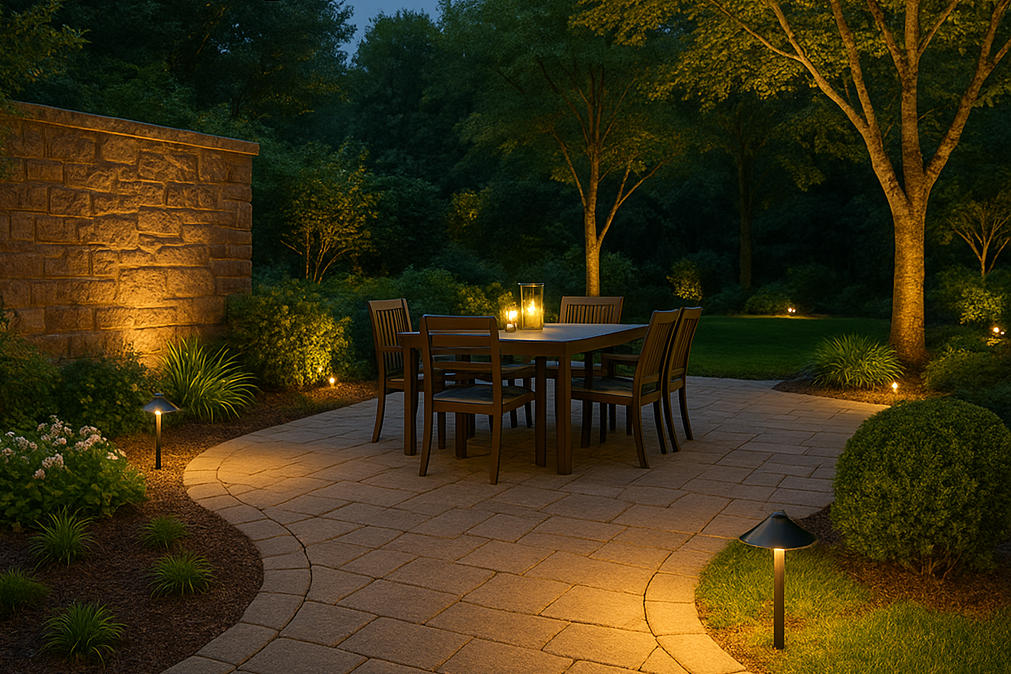
Landscape lighting is essential in modern outdoor living. Outdoor living spaces have evolved from simple backyard setups into multifunctional extensions of the home. As patios, decks, gardens, and pool areas become central spots for relaxation and entertaining, the importance of landscape lighting grows. Beyond mere aesthetics, the right lighting setup serves a critical dual role: enhancing the beauty of your space while ensuring safety for everyone who enjoys it. In this article, we’ll explore how landscape lighting enhances safety and ambiance in outdoor living areas, offering practical insights and real-world examples.
Table of Contents
The Dual Role of Landscape Lighting
Lighting for Safety and Security
Safety is a foundational reason to invest in outdoor lighting. Properly placed lights illuminate paths, stairs, and driveways, preventing trips and falls. Entrances and garage areas benefit from motion-activated lights, which not only enhance visibility but can also act as a deterrent to potential intruders.
Lighting key access points ensures that residents and guests can move around confidently at night. Path lights, for example, define walkways and edges. Step lights prevent missteps on uneven terrain. Spotlights on doors and gates clarify where it’s safe to walk and where to unlock a door without fumbling.
Security lighting is equally crucial. Dark corners or blind spots in a yard can be inviting to trespassers. Floodlights and motion sensors add a layer of protection. Even strategically placed accent lights can give the impression that someone is home, discouraging break-ins.
Lighting for Aesthetic Ambiance
Outdoor lighting isn’t all about functionality—it plays a huge role in setting the mood. Accent lighting can highlight architectural features, water elements, or specimen plants. Warm lighting along garden borders or in tree canopies creates an inviting glow, encouraging people to linger outside.
Uplighting can dramatize the texture of a stone wall or cast stunning shadows through tree branches. String lights hung above a dining space infuse charm and intimacy. Well-placed lights can visually expand the size of your yard, make cozy corners feel more accessible, and allow your outdoor design to shine, even after sunset.
In essence, the interplay between light and shadow adds a dynamic quality to your space. It guides the eye, enhances textures, and evokes emotions—whether that’s peace, excitement, or elegance.
Types of Outdoor Landscape Lighting
Path Lights
Low-mounted fixtures essential for guiding guests along walkways, garden paths, and steps. They provide both safety and structure to the landscape. Path lights are typically spaced evenly to create a uniform glow and are often used to outline flower beds or driveways, enhancing both security and curb appeal. Many models come with adjustable brightness or solar capabilities, making them efficient and adaptable.
Spotlights and Uplights
Spotlights highlight specific features like trees, sculptures, or facades. Uplights placed at ground level illuminate vertically, adding drama and depth. These are ideal for showcasing tall trees, stone pillars, or fountains, drawing attention to your landscape’s architectural and natural highlights. You can angle spotlights to cast shadows for added texture or cluster them for bold illumination.
Deck and Step Lights
Integrated into stairs or decking, these reduce tripping hazards and offer a subtle, sophisticated glow. Ideal around pools or outdoor lounges where visibility matters, these lights are often embedded flush into the surface for a clean look. They can also add ambiance to railings or seating areas, improving both function and style during evening entertaining.
Wall Washers
These lights bathe large surfaces—like garden walls or fences—in soft illumination. They make spaces feel broader and enhance texture. Wall washers can create a serene backdrop or highlight the structure of your home, blending seamlessly with exterior finishes. When paired with greenery or textured surfaces, they provide a dramatic and polished appearance.
String Lights and Ambient Fixtures
Perfect for patios and pergolas, string lights are both functional and whimsical. They add a festive and welcoming touch to any outdoor area. You can drape them overhead to define a gathering space or wrap them around trees and posts for a magical garden glow. Available in various color temperatures and styles—from vintage bulbs to fairy lights—these fixtures can complement almost any design theme.
Solar vs. Wired Lighting
Solar lights are eco-friendly and easy to install but rely on consistent sunlight. They’re great for accent lighting or areas that receive full sun exposure. Many modern solar options include motion sensors and dusk-to-dawn features.
Wired lighting offers more reliable brightness but may require professional installation. It’s the preferred choice for areas requiring consistent illumination, like driveways or entrances. With transformers and timers, wired systems can be automated for energy efficiency and convenience.
Choosing the best option depends on your budget, landscape layout, lighting goals, and the level of maintenance you’re willing to commit to.
Design Principles to Balance Safety and Beauty
Layering Light: Ambient, Task, and Accent
A well-lit landscape doesn’t rely on a single type of light. Layering ensures coverage and atmosphere. Ambient lighting provides general visibility across larger areas, helping people navigate with confidence. Task lighting is focused and functional—ideal for illuminating steps, outdoor kitchens, or seating areas. Accent lighting introduces artistry and drama, drawing attention to specific features like a fountain or a tree.
Combining these three types creates a visually balanced and practical environment. Think of ambient light as your canvas, task lighting as your guide, and accent lighting as your brushstroke of personality.
Light Placement Strategy
Strategic placement is just as important as the type of light used. Poorly positioned lighting can lead to glare, discomfort, or unflattering shadows. To avoid this, favor indirect lighting techniques like wall washing, backlighting, or uplighting, which are more comfortable and aesthetically pleasing.
It’s also essential to consider height and angle. For instance, mounting lights too high can create harsh shadows, while placing them too low might limit their effectiveness. Play with distances and elevations to get the right balance between functionality and beauty.
Avoiding Over-illumination and Light Pollution
Too much light can overwhelm a space, wash out textures, and disrupt the natural atmosphere of your yard. Over-illumination can also spill light into unwanted areas, contributing to light pollution that affects wildlife and sleep cycles.
To mitigate this, use dimmers to fine-tune brightness levels. Motion sensors can reduce energy waste by only activating lights when needed. Timers allow you to automate your system and ensure that lighting follows a sensible schedule throughout the evening.
Coordinating Fixtures with Outdoor Features
Your lighting fixtures should complement the aesthetic of your landscape. Bronze and copper finishes suit rustic or natural themes, while stainless steel or matte black fixtures enhance modern or minimalist designs.
Color temperature also plays a crucial role: warm white lights (around 2700K–3000K) are soothing and flattering, ideal for wooden decks, gardens, and stonework. Cooler tones (4000K–5000K) feel more clinical and crisp, often better suited for concrete paths or contemporary spaces.
By harmonizing fixture style and light temperature with your existing materials and architecture, your lighting will feel intentional and visually cohesive.
Landscape Lighting Planning Guide
Evaluate Your Outdoor Space
Take a nighttime walk through your yard to spot dark areas, hazards, and key features you’d like to showcase. Observe how you use each zone—where people gather, where visibility drops, and which areas feel unsafe. Use a flashlight or your phone to simulate where lighting might be useful. Take notes or even photos for reference. This step helps identify both problem spots and opportunities for enhancing your landscape’s beauty.
Define Purpose and Budget
Determine if your primary goal is safety, aesthetics, or a combination of both. Are you lighting paths for late-night walks, highlighting a water feature, or enhancing security? Clarifying your objectives will guide fixture selection and help you prioritize lighting zones. Then, establish a budget that includes both the upfront installation costs and the ongoing maintenance—such as bulb replacements or cleaning lenses.
Sketch a Layout Plan
Create a simple diagram of your outdoor space, either by hand or using free landscape design tools. Mark different zones—walkways, patios, gardens, entrances—and indicate where you plan to install fixtures. Include distances from power sources, trees, and other landmarks. Label the types of lighting you’ll use in each area and estimate how much light coverage is needed. This plan will be your blueprint for selecting and placing fixtures effectively.
Choose the Right Fixtures
Select lighting fixtures based on the function they’ll serve. Use spotlights to highlight trees or architectural details, path lights for walkways and driveways, and wall sconces for patios and entrances. Choose fixtures that are rated for outdoor use and made from materials suited to your climate—like stainless steel for humid environments or powder-coated aluminum for general durability.
Consider features like brightness levels, color temperature, and beam spread. Adjustable fixtures can give you flexibility, while integrated LED options offer energy efficiency and longer lifespan.
Installation Considerations
Decide whether you’ll go the DIY route or hire a professional. Wired systems offer consistent brightness and durability but may require trenching, conduits, and a transformer. Solar lights are easier to install and eco-friendly but less powerful and dependent on sunlight. Use waterproof connectors, proper sealing techniques, and corrosion-resistant materials to extend the life of your installation.
Also, take safety precautions: always turn off electricity at the breaker box before working on wiring, and use landscape-rated cables for in-ground installation.
Smart Lighting Controls
Modern landscape lighting can be automated for convenience and efficiency. Use programmable timers to control when your lights turn on and off, or install motion sensors for lights that activate only when movement is detected—great for security and energy savings.
App-controlled lighting systems let you adjust brightness, colors, and timing from your smartphone, even when you’re not home. Integrating smart features not only makes your system easier to manage but also adds a layer of sophistication and flexibility that elevates your outdoor living experience.
Real-Life Applications and Case Studies
Front Yard with Motion Lights
A suburban homeowner in New Jersey installed motion-activated path lights along the driveway and porch. The result? Fewer missed steps at night and a 30% drop in neighborhood break-ins.
Backyard Entertaining Zone
One family designed their patio with string lights, recessed deck lights, and uplights on nearby trees. The layered approach created a cozy space ideal for evening meals and weekend parties.
Pool Area with Underwater and Accent Lighting
In a modern home with a pool, underwater LED lights changed color and accented surrounding plants with soft spotlighting. It enhanced nighttime swims and added a luxurious touch.
Driveways and Garden Paths
In a coastal home, landscape designers used solar lights to line winding garden paths. They chose warm white tones to match the natural foliage, improving navigation and reducing energy use.
Conclusion
Landscape lighting is more than decoration—it’s a crucial element of outdoor living that blends form and function. By thoughtfully illuminating your exterior spaces, you make them safer, more usable, and infinitely more beautiful.
With the right combination of lighting types, careful planning, and smart technology, any outdoor area can become a haven after dark. Whether your goal is to host unforgettable backyard parties or simply walk to your door without tripping, investing in quality landscape lighting is a decision that brings long-term rewards.
Ready to transform your outdoor space? Visit Cedar Bridge Landscape Supply for expert advice, premium materials, and everything you need to illuminate your landscape beautifully and safely.


